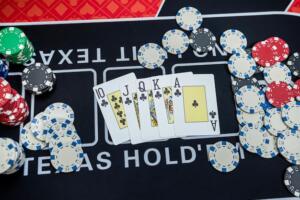Mastering Turn Probes: Understanding the Reckless Player
In the world of poker, players come in various styles, each with unique strategies and tendencies. In the first part of this series, we explored the risk-averse player profile, a common type known for their cautious approach to betting. Now, let’s shift our focus to another prevalent opponent type: the reckless player. This article will examine the reckless player’s strategy, how it operates, and how to master turn probes against them.
- Definition: Reckless players lack a calibrated understanding of risk versus reward.
- Common Mistakes: They over-invest their equity at nearly every point in the game.
- Exploitation: Risk-averse opponents can easily capitalize on their style.
- Preflop vs. Postflop: The dynamics change significantly after the flop.
- Modeling Strategies: Analyzing the reckless player’s responses to probing bets.
Defining the Reckless Player
The reckless player is characterized by a lack of understanding of the risk-reward ratio that governs poker. This misunderstanding leads them to over-invest their equity at almost every decision point in the game tree. Unlike the risk-averse player, whose style is relatively common, the reckless player is less prevalent due to the inherent flaws in their strategy. They often face risk-averse opponents, who exploit their tendencies, leading to consistent long-term losses for the reckless player.
Common Traits of Reckless Players
Reckless players often exhibit several defining traits:
- They tend to bet almost exclusively with high-equity hands, such as top pairs and strong draws.
- They frequently call with weak hands, including low pairs and two overcards, even when the board is unfavorable.
- Their betting patterns suggest a lack of understanding of pot odds, as they often invest in situations where the odds don’t justify their calls.
The Impact of Strategy on Outcomes
To illustrate the reckless player’s approach, consider a scenario where one player bets with high-equity hands, while their opponent calls with marginal hands. When this matchup is played over a million hands, the player leveraging their money with high equity consistently ends up with the majority of the winnings. The reckless player’s low-equity strategy is unsustainable in the long run, leading to significant losses.
Preflop Considerations
One of the primary reasons reckless players are exploited is their preflop strategy. They often over-invest in situations where folding would incur no expected value loss. Each time they push chips into the pot with a marginal hand, they leak money before the actual game begins. This tendency is a significant flaw that risk-averse players can exploit effectively.
Postflop Dynamics
Postflop play introduces more complexity. The battle between the average risk-averse player and the reckless player becomes more balanced. Reckless players can win pots by bluffing risk-averse opponents, while the latter can capitalize on value betting against the reckless player’s tendencies. This tug-of-war between over-bluffing and over-folding creates opportunities for both player types to exploit each other’s extremes.
Understanding Risk-Averse Strategies
Before diving deeper into the reckless player’s strategy, it’s essential to outline how risk-averse strategies typically manifest. These strategies often include:
- Folding more often in marginal situations.
- Value betting with strong hands while avoiding unnecessary bluffs.
- Adjusting bet sizes based on the strength of their hands.
While these small deviations might seem harmless individually, they create predictable patterns that can be exploited by both reckless and disciplined players.
Modeling the Reckless Player
To better understand the reckless player’s strategy, let’s model a scenario where you’ve called from the Big Blind against a Button open-raise, and the flop comes Js 8s 3d. It’s crucial to note that the reckless player’s flop c-betting strategy often resembles a Game Theory Optimal (GTO) strategy. This similarity arises because GTO lacks a built-in risk aversion bias, allowing for a mix of calculated frequencies that mirror the reckless player’s random strategic choices.
Probing Bets: Defensive Strategies
When analyzing the reckless player’s responses to probe bets, we’ll focus on two preferred sizes: the overbet and the block bet. Against the overbet, the reckless player’s defending strategy often includes:
- A tendency to call with draws and pairs, rarely folding any draw or pocket pair above middle pair.
- A slight adjustment to their folding range, reducing it from 53% to 46% to reflect real-game scenarios.
This adjustment creates a more realistic defense profile, highlighting the reckless player’s inclination to call rather than fold, even in unfavorable situations.
Responding to the 33% Pot Probe Bet
Next, let’s examine how the reckless player responds to a 33% pot probe bet. In this context, the reckless player’s calling range may include:
- All Ax hands with two overcards to the middle pair.
- All Kx hands with two overcards to the middle pair.
- All pocket pairs, including low pairs like 22.
This modeling demonstrates the reckless player’s willingness to call with a broader range of hands, further emphasizing their tendency to over-invest in marginal situations.
Delayed C-Betting Strategy
Another aspect of the reckless player’s strategy is their delayed c-betting. Based on database analysis, this player type tends to fire delayed c-bets approximately 6% more often than optimal. Additionally, they bluff more frequently than ideal, though quantifying this margin can be challenging due to showdown bias. Their bet sizing also skews toward smaller bets, often leaning heavily toward 33% and 50% pot bets.
Comparing Strategies: GTO vs. Reckless Players
For comparison, let’s look at the GTO delayed c-bet strategy. The reckless player’s model, however, adjusts by collapsing sizing into a single 75% pot option and including a higher percentage of bluffs—53% of their betting range compared to 49% in the GTO model. This adjustment highlights the reckless player’s inclination to over-bluff, further showcasing their flawed understanding of risk versus reward.
Reader Q&A
What makes a player reckless in poker?
Reckless players often lack an understanding of the risk-reward ratio, leading them to over-invest in marginal hands and situations.
How can I exploit a reckless player?
Focus on value betting strong hands and capitalizing on their tendency to call with weak holdings, particularly preflop.
Are reckless players common in professional poker?
While less common than risk-averse players, reckless players can still be found in various levels of play, often leading to consistent losses.











